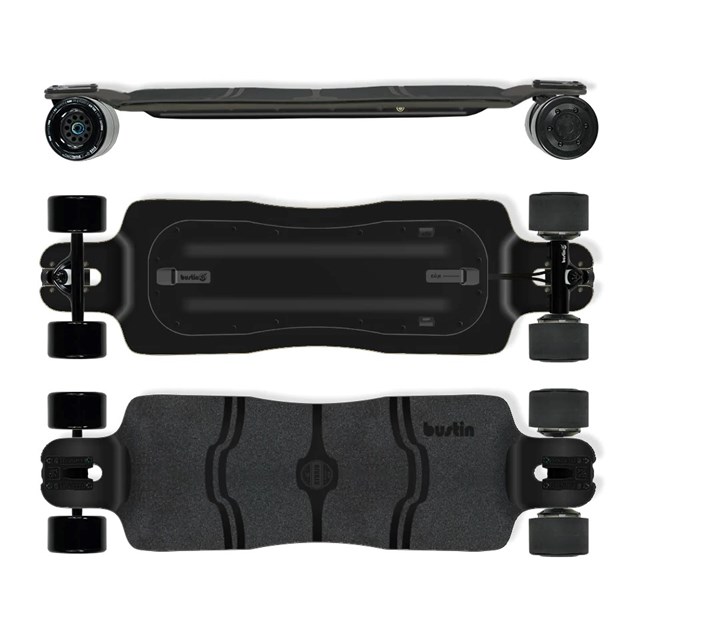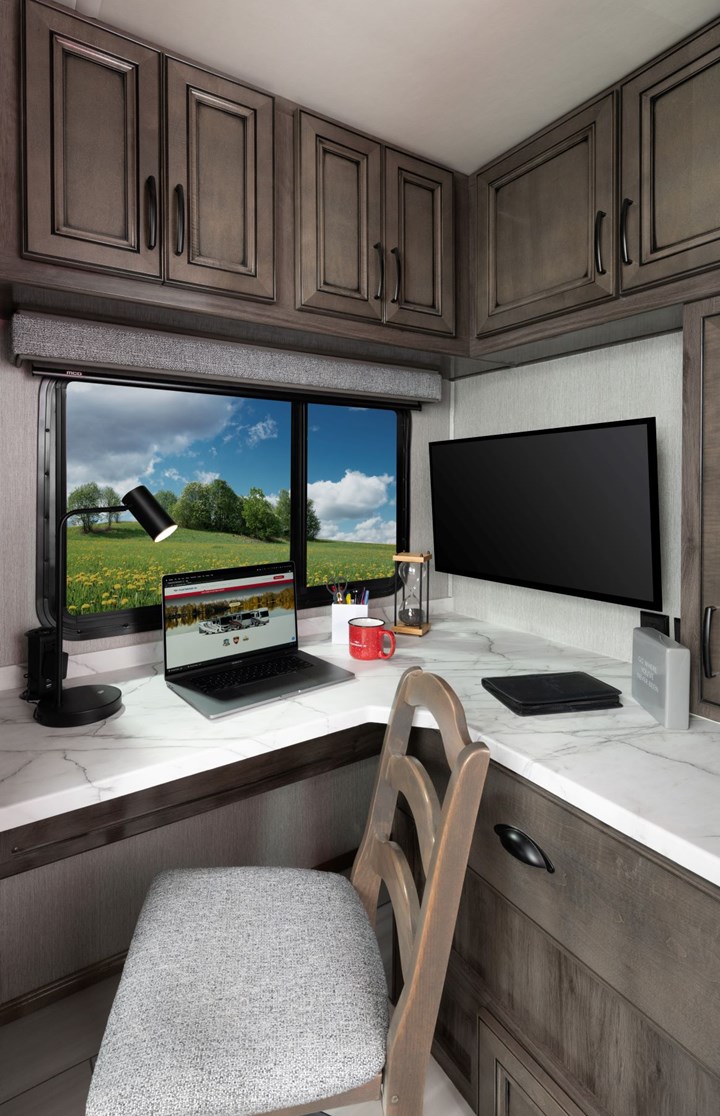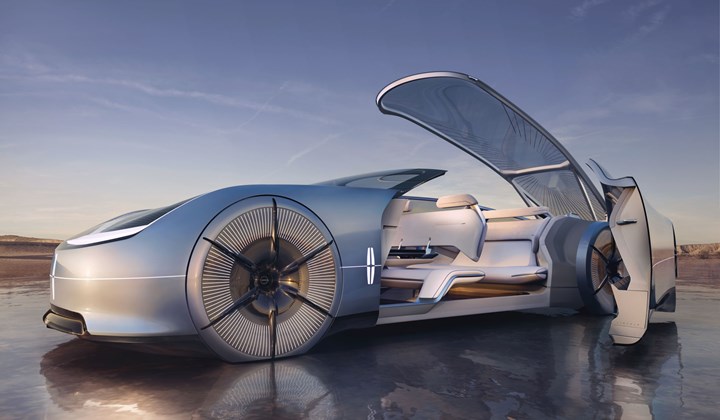on EV Charging, Hybrid Skateboard, an Office on Wheels, Lincoln Concept, Solar Power, & ADAS Terms
People are not particularly pleased with EV charging. You could commute. . .on a hybrid skateboard. Or you could get an office in an RV and never go back. Lincoln looks to the future while acknowledging its past. Solar power is being used for refrigeration. More ADAS terms to know.
The EV Charging Challenge

Perhaps no surprise: Tesla charging capabilities came out on top for consumers in the J.D. Power study. (Image: Tesla)
Last year the Fuels Institute released a study that it had contracted Ricardo Strategic Consulting to perform on the subject of electric vehicle owner behavior.
It found, in part:
“EV drivers tend to recharge daily or once every two days, typically overnight at home, and overall, about 70-80% of charging occurs at home or at a workplace parking lot.”
Two thoughts to keep in mind:
- In 2020 (the year that study’s data relates to) there were 308,000 plug-in vehicles sold in the U.S., according to the U.S. Dept. of Energy. That number rose to some 608,000 in 2021. According to Kelley Blue Book, during the first half of 2022 there were 370,726 electric vehicles sold in the U.S. So if that pace continues there will be some 740,000 sold in 2022.
- Although the vast majority of charging occurs at home or work, it still means that 20-30% is performed elsewhere.
More EVs = More Charging
Which makes the results of the second annual J.D. Power U.S. Electric Vehicle Experience Public Charging Study all the more interesting.
Briefly, people are less satisfied with public Level 2 charging than they were last year and their assessment of DC fast charging is flat, not improved.
On a scale of 1,000 points, Level 2 has gone from 643 in 2021 to 633 this year. DC fast charging holds at 674.
Or, since back to school is upon us, the public chargers are both in the grade “D” category.
J.D. Power says the #1 reason people reject EVs is public charging availability.
Sure, the number of chargers is growing. But with that growth there doesn’t seem to be growing satisfaction.
Really not good
“Not only is the availability of public charging still an obstacle, but EV owners continue to be faced with charging station equipment that is inoperable. The National Electric Vehicle Infrastructure (NEVI) Formula Program promises to provide funds to states for building out their EV public charging infrastructure. This will lead to sizable growth in the availability of EV charging stations, but just adding stations isn’t the answer. Stations need to be added to areas where there are currently gaps in heavily traveled routes and in high-density areas for people who don’t have access to residential charging, but most importantly, designed with things for users to do while charging—regardless of the use case. Then, we need to make sure those stations are reliable.”—Brent Gruber, executive director of global automotive at J.D. Power
Pay close attention to that last word: Reliable.
J.D. Power found that as the number of EVs is rising, “owners in high EV volume markets like California, Texas and Washington. . .are finding the charging infrastructure inadequate and plagued with non-functioning stations.”
Putting some numbers to the issue of reliability, the study found that one out of five respondents rolled into a public EV charging station. . .and left without charging.
The reason?
72% said the station was malfunctioning or out of service.
(Yes, users of both the Tesla Destination and Tesla Supercharger networks were the most satisfied of all the brands surveyed.)
>>>
Board Back to School

This is a hybrid. You can use leg power or electrical power. Yes, it is a skateboard. But it can go up to 30 mph. (Image: Bustin Boards)
Speaking of back to school. . .
Here’s an alternative to taking the bus: a hybrid skateboard.
Yes, “hybrid” as in having two separate sources of power: one’s leg and in the case of the Bustin Sportster Hybrid V3, hub motors.
The deck: 35.5 inches long, 10 inches wide and a 29 to 29.8-inch wheelbase. Made with a glass-fiber composite that has a CNC-cut cavity into which the power electronics and 324-Wh Samsung batteries are fitted. That section is covered with a fiber-reinforced polycarbonate case.
Top speed: 30 mph.
Range: 18 to 20 miles.
These boards, manufactured in Maryland, aren’t, however, cheap:
They’ll set you back by about $1,000.
However, given the average price of a used car—we don’t even want to think of the price of a new vehicle—was $28,219 in July, according to Cox Automotive, maybe this micromobility solution is advantageous.
Also. . .
The micromobility market in the U.S. is estimated to be $200 billion and $300 billion by 2030, according to Statista.
Certainly something not to overlook.
>>>
A Different Approach to the Office

When “getting back to the office” means going to a section of an RV. (Image: Fleetwood)
For those not going back to school. . .
Let’s face it: the pandemic has had a continuing effect on people’s perspectives regarding working in the office when said office is in an office building wherein there are X-number of other people.
So to address the needs of those people who would rather not be figuratively tied down day after day in a static office, Fleetwood RV has launched a new 37-foot diesel-powered motor home, the Frontier GTX 37RT, that’s available with an option: “The Corner Office.”
“We developed the 37RT office configuration after listening to our current customers, as well as new owners entering the RV space. We found quite a bit of interest in the ability to work remotely and have children engage in distance learning. Based on that, we wanted to offer a floor plan that could accommodate the new reality of living, working, and educating anywhere.”--Doug Miller, product manager for REV Recreation Group’s Class A products
The Corner Office includes an L-shaped desk with a built in monitor. There are numerous power outlets and storage spaces.
There is another optional package to increase connectivity that includes “WiFi Ranger Sky4 ProPack w/LTE and weBoost Cell Booster.”
To take advantage of, well, not being in a corporate park, there is a large window conveniently located above the desk for the likelihood that there will be something to see other than other buildings, parking lots or the like.
The vehicle is powered by a Cummins 6.7-liter 360-hp engine that is mated to an Allison 3000 series six speed. There is a 100-gallon fuel tank, so getting away from it all while staying connected to it all is easily accommodated.
>>>
Lincoln Yesterday and Tomorrow

Yes, this is a Lincoln concept of a potential vehicle, but realize that today’s concepts can become tomorrow’s reality. (Image: Lincoln)
Quick History Lesson
Although Lincoln is celebrating its centenary this year, it was actually founded in 1917 by Henry Leland. Yes, the man who had established Cadillac in 1902. And as these things sometimes happen: Cadillac was built on the remains of the Henry Ford Company, Henry’s second company. (Third time was a charm for him.)
Leland’s Lincoln became insolvent in 1922. . .and the Ford Motor Company (i.e., Henry’s third) bought it.
Thus, the 100-year celebration.
The first car that was put out by Lincoln was the L series (although it came out pre-Ford, in 1920). It became known as the “Model L.” (If you sometimes think that vehicle names are unimaginative today, think of that.)
Back to Real Time
All of which is a long way to get to the Lincoln Model L100 Concept that was introduced last week.
Not surprisingly, it is imagined as an electric, autonomous vehicle.
Xitij Mistry, Lincoln Exterior Design Manager and Ryan Niemiec, Lincoln Interior Design Chief, headed the execution of the sleek, low car.
(Yes, in the future people will still drive—or be driven in—cars.)
A few things to note:
- There is an extensive use of glazing, from the hood all the way to the decklid. Although this is a concept, metal formers might put a pin in this. There is lots of exterior that isn’t metal.
- Speaking of sheet metal, the shiny trim is not chrome: they used metallic paint and frosted acrylic instead.
- There is a nod to other Lincolns. According to Hagerty, “The 1961–69 Lincoln Continental was . . .one of the final cars to feature suicide doors (until they were revived by Rolls-Royce in the 2000s).” For model year 2019 Lincoln launched the Continental 80th Anniversary Coach Door Edition, which features a set of rear-hinged doors. The concept car has rear-hinged doors. Lincoln is nothing if not respectful of its past, even when imagining its future.
Kemal Curic, Lincoln global design director:
“This concept allowed us to design a new experience that is unburdened by past limitations and represents an evolution of our Quiet Flight tenets. The ultimate expression of our Model L100 design is one that moves effortlessly—a vehicle that appears to be sculpted by the wind, as if friction does not exist.”
>>>
Using the Sun to Cool a Reefer

Those black panels on the semi trailer are photovoltaic cells that are being used to power a refrigeration unit. (Image: Sono)
Think about the size of a trailer being pulled by a long-haul truck. There’s a lot of exterior real estate.
Sono Motors, a German company, has come up with something to do with much of that space and is working with CHEREAU S.A.S., a subsidiary of the Reefer Group, to build a refrigerated truck trailer that will have 58.9 square meters of solar panels on its exterior.
The solar panels are said to provide up to 9.8 kW of peak energy. The energy will charge a battery. The battery will then operate the cooling unit.
According to Sono, compared to trucks with diesel-powered cooling systems this will provide an annual fuel savings of ~3,400 liters and reduce CO2 emissions by some 9 tonnes.
Knowing that making the 54 photovoltaic panels that are to be applied to the trailer involves CO2, too, the company has calculated that the process produces 6.5 tonnes of CO2, so in less than a year that’s accounted for.
The refrigerated trailer will have its public debut at next month’s IAA Transportation expo in Hanover, where it will share the stand with several other solar-enhanced vehicles.
Sono Motors has more than 17 commercial contracts with companies including MAN and the Münchner Verkehrsgesellschaft.
Hmm. . .
Here’s a thought: There are 1,631 hours of sunshine per year in Hanover according to the German Meteorological Service.
Los Angeles has about double that.
That’s a lot of sunshine that is going to vehicular waste.
>>>
ADAS Terms to Know (3)
I forgot to put in these of terms defined by AAA, Consumer Reports, J.D. Power, National Safety Council, PAVE, and SAE International to make things more understandable regarding autonomous tech in last week’s edition, so now we are in week four but only on category three:
DRIVING CONTROL ASSISTANCE
Adaptive Cruise Control Cruise control that also assists with acceleration and/or braking to maintain a driver-selected gap to the vehicle in front. Some systems can come to a stop and continue while others cannot.
Lane Centering Assistance Provides steering support to assist the driver in continuously maintaining the vehicle at or near the center of the lane.
Active Driving Assistance Simultaneous use of Lane Centering Assistance and Adaptive Cruise Control features. The driver must constantly supervise this support feature and maintain responsibility for driving.
///
RELATED CONTENT
-
On Zeekr, the Price of EVs, and Lighting Design
About Zeekr, failure, the price of EVs, lighting design, and the exceedingly attractive Karma
-
On Advanced Design, Brain Function, and Quantum Computing
All about a solar sedan, a new GM design campus, Volvo’s impressive XC90, Porsche first-half sales, Nissan’s brain studies (!), Lucid Care for Lucid Air, and VW’s quantum computing
-
Things to Know About Cam Grinding
By James Gaffney, Product Engineer, Precision Grinding and Patrick D. Redington, Manager, Precision Grinding Business Unit, Norton Company (Worcester, MA)


.jpg;width=70;height=70;mode=crop)






